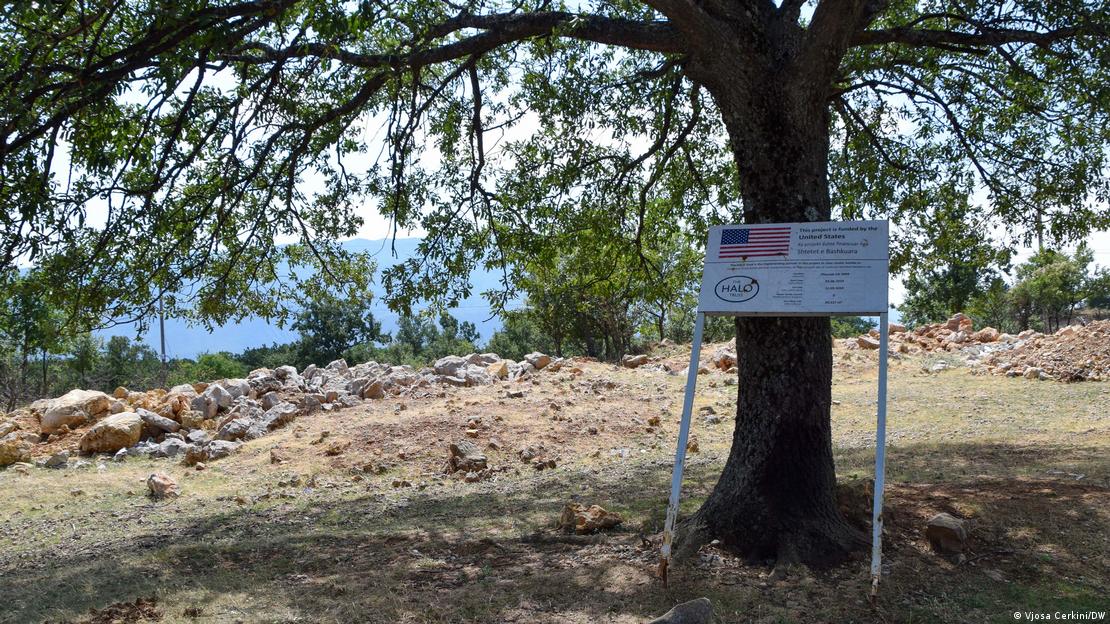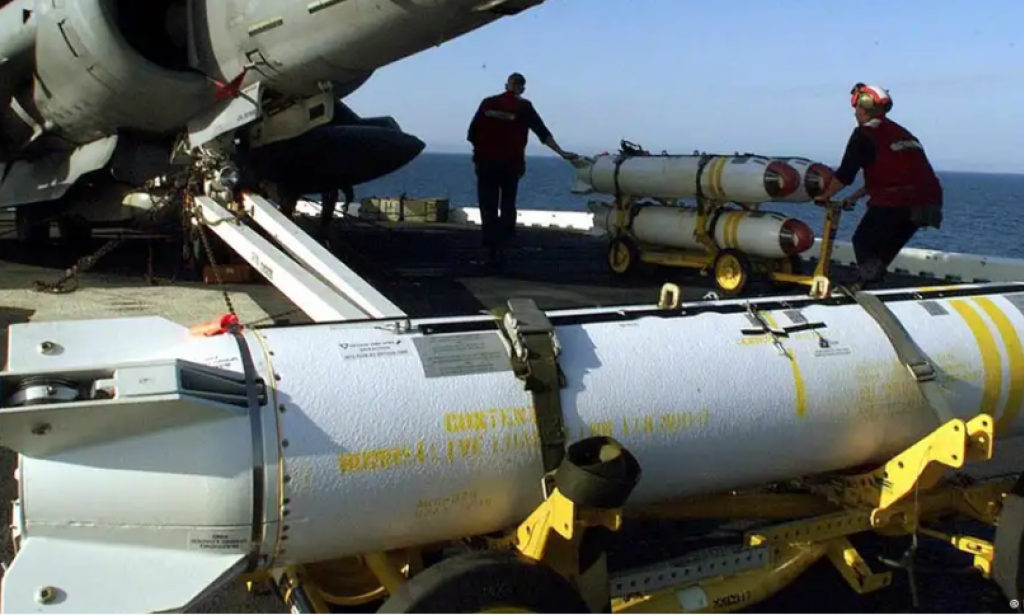1999年3月,一架美国战斗机在阿尔巴尼亚海岸附近装载了含有贫铀弹的炸弹,这些炸弹后来被用于科索沃战争。图片: Mike Nelson/dpa/picture alliance
“我清楚地记得最后一天,”意大利红十字会军事部门前上校埃梅里科·玛丽亚·拉切蒂说道。
1999年科索沃战争期间,他驻扎在阿尔巴尼亚,距离科索沃边境仅几百米。他当时是为来自该省(当时属于 塞尔维亚)的难民设立的野战医院的指挥官。
“我们站在集装箱上观看轰炸,”他说。“那就像一场扭曲的新年烟火表演。即使隔着一段距离,你也能感觉到气压,感受到冲击波穿过你的身体。但是,我们却没有人告诉我们所用武器的具体危险性。”
In March 1999, NATO's Operation Allied Force intervened in the conflict between the Serbian state and the Albanian majority population in Kosovo, which had been simmering for years. Over 78 days, the alliance flew missions with up to 1,000 aircraft against Serbian security forces. According to official figures, over 28,000 explosive devices were dropped, including controversial uranium ammunition, which is suspected of causing cancer.
This ammunition contained a core of depleted uranium (DU), with high explosive power due to its high density, three times denser than lead. It is therefore used primarily against tanks and armored targets. Its impact can produce fine uranium dust, which continues to emit radiation and can cause health problems, for example, if it is inhaled.
NATO rejects cancer accusations
In response to questions about the health risks posed by DU ammunition, NATO only gave a written statement. "We take health and environmental issues very seriously," it said.
In 2001, a committee on DU concluded that the use of DU ammunition in Kosovo "did not cause any lasting health risk to the population," citing independent findings.
NATO refers to UN reports from 2014. "This is scientific evidence; it was reliable, and we stand by it," the military alliance said in a statement.
However, this contradicts the rulings of Italian courts on lawsuits filed by approximately 500 Kosovo War veterans who developed cancer after coming into contact with depleted uranium ammunition.
Laccetti says he was aware that his field hospital in Morina, Albania, was located in a "hot zone," close to an active conflict, during the NATO bombings — something that would always entail risk.
"What we were never told, however, was that certain types of ammunition can pose long-term danger, even if you are not directly hit — for example, from an unexploded ordnance nearby or from substances used in ammunition production."
Triggering long-term illness
When Laccetti returned home in July 1999, he experienced breathing difficulties and went to the hospital to be examined. "The medical staff suddenly became very flustered," he recalled.
Finally, a doctor showed him the image: "There was something in my lung measuring 24-by-12-by-14 centimeters (9.4-by-4.7-by-5.5 inches)." The then 36-year-old was diagnosed with a very aggressive malignant tumor.
Laccetti was initially treated successfully, but in 2008, he fell ill with cancer again. The results of the tissue examination were alarming. "They found an extraordinary amount of perfectly round ceramic particles — as if I had been standing in a blast furnace."
The conclusion was clear: "These particles had become lodged in my body over many years and could cause new damage through migration or inflammation."


Successful lawsuits in Italy
Laccetti learned of other soldiers of the same age who had been stationed nearby and received similar diagnoses. He contacted lawyer Angelo Tartaglia, who represented those affected.
Approximately 500 military personnel successfully sued the state of Italy. Among them was Laccetti, whom a court in Rome certified in 2009 as a victim because he had fulfilled his military duties. The court awarded him compensation.
After the Kosovo War, a commission of the Italian Ministry of Defense investigated a possible link between DU exposure and cancer. It found a statistically significant increase in the incidence of non-Hodgkin lymphoma, a group of blood cancers, among affected soldiers. However, other studies, such as a WHO report from the same year, found no clear evidence of a direct link between DU and individual cases of disease.
Difficult to prove a cancer link
For Wim Zwijnenburg, a member of the International Coalition to Ban Uranium Weapons (ICBUW), the case is clear-cut.
"The judge recognized that the Italian state had a duty of care, which is why compensation was awarded," explained Zwijnenburg, who has been investigating the use and consequences of DU for over 16 years.
"My conclusion is it is extremely difficult to make a definitive statement," he admits, because depleted uranium only has an effect when it enters the body, usually in the form of fine dust particles that are inhaled. "But the exact amount that people actually absorb has never been properly measured. There are very few reliable long-term studies."
The causes of cancer are often difficult to pinpoint. Unhealthy lifestyles, environmental influences, genetic predisposition and many other factors contribute to the number of cases.
"It's difficult to prove," says Zwijnenburg. "Have those affected ever touched a DU grenade or been near a contaminated tank? Uranium can take a year to penetrate the skin. Doctors cannot make any claims if it is not completely clear. People are looking for a clear cause, but the reality is far more complex."


Did NATO do enough to clean up Kosovo?
In 2002, the United Nations passed a resolution obliging countries to inform affected states after the use of uranium ammunition and to assist in the cleanup of contaminated areas. It is unclear to what extent NATO fulfilled this responsibility in Kosovo — the NATO peacekeeping force KFOR, which has been stationed there since the end of the fighting to secure peace, does not provide any information.
Visits to the sites show that the population in many regions of Kosovo is unaware of the potential risks, and decontamination measures have not been carried out, except at one site in the west of the country, in the village of Lugbunari near Gjakova.
专家维姆·兹维嫩堡表示:“北约或许会因使用这些武器而受到批评,但更应受到谴责的是战后没有进行清理工作。士兵有明确的防护措施,但平民呢?什么都没有。使用有毒弹药后就置之不理,这是不可接受的。”
官方而言,贫铀弹药的制造材料被归类为低至中等放射性废物。但兹维嫩堡表示,“在巴尔干半岛等潮湿气候下,炮弹会发生腐蚀和解体,留下危险的残留物。”


随着时间的推移,风险也不会消失,因为铀的半衰期几乎是无限的。兹维嫩堡认为,这证明了各国奉行双重标准。
“如果在荷兰的公园里发现这种手榴弹,该区域将被封锁。身穿防护服的特种部队会将手榴弹放入铅制容器中并安全存放。” 因此,当涉及到本国人民的安全时,风险会被极其认真地对待——但在其他地方,情况却并非如此。
拉切蒂对他的案件以及许多其他退伍军人的案件未能带来任何根本性的改变感到失望。“贫铀弹药仍然合法。我们已经尝试了所有可能的方法来禁止它,就像禁止集束弹药或杀伤人员地雷一样,”他说。“我们失败了。”
罗马的 Gabriele Cruciata 和乌得勒支的 Marjolein Koster 也对此报道做出了贡献。
本文的研究工作得到了欧洲新闻基金会的支持。
本文最初以德语发表。



You must be logged in to post a comment.